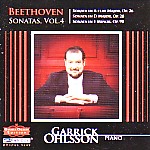As with several previous installments of this Beethoven cycle, pianist Garrick Ohlsson uses a rebuilt Mason and Hamlin grand, whose slightly nasal timbre changes from register to register and takes on a smoky, veiled quality when the una corda pedal kicks in. Was Ohlsson in a sober and staid mood when he recorded these three lyrically-minded works in May, 2007? Every one of the Op. 28 sonata’s notes and phrases fits into proper place, and you cannot fault the pianist’s textural cultivation and meticulous voice-leading (the first movement’s development section, for example). But there’s little sense of character and contrast to the Andante’s woodwind-like bass lines or the Scherzo’s motivic quirkiness. The Finale’s broken octaves sacrifice urgency for spotless accuracy, and the treacherously difficult coda, though impeccably executed, seems to be spliced in from another composition–and hardly stings you with surprise. Op. 90’s second movement represents a plodding and prosaic manifestation of the refined intimacy Kempff and Moravec achieve in their far more inspired recorded versions.
Ohlsson proves most involved and engaged throughout the Op. 26 “Funeral March” sonata. Note the subtle yet wide range of expressive nuance and harmonic inflection that colors the pianist’s rigorous and unified tempo relationships in the first-movement variations, the Scherzo’s characterful articulation, and the Funeral March movement’s sonorous interplay. At Ohlsson’s conservative tempo, the Allegro finale’s rotary patterns take on a melodic definition that does not often come across in more brisk, more mechanical performances. If Op. 26 is your main interest, you might consider checking out this well recorded, intelligently annotated, yet uneven release.
































